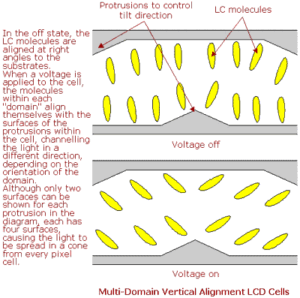While Hitachi was developing its In-Plane Switching (IPS) Super TFT, Fujitsu and the chemical giant Merck were taking a different approach to increasing viewing angles and, in 1996, announced the development of a new liquid crystal mode, known as Vertical Alignment (VA). In VA, as the name suggests, the molecules of liquid crystal are normally aligned at right angles to the substrates, swinging through 90° to lie parallel with the substrates in the presence of an electromagnetic field. This new mode produces a display which, like Hitachi’s, has an ultra-wide viewing angle (140° in all directions) and high contrast but with the added bonus of higher brightness and a response time of 25 milliseconds, shorter than for IPS and STN LCDs. The display also consumes less power than IPS but, is still too power hungry for battery-power applications.
The following year, 1997, Fujitsu used the VA mode LC in conjunction with a technique of aligning crystals at a sub-pixel level which uses UV light instead of the more usual rubbing. Developed by Rolic, and first used in a display by NEC, the technique involves the addition of pyramid-shaped protrusions within each LC cell, the surfaces of which each make up a separate “domain” in which the LCs are aligned differently from those in the other domains. It produces increased viewing angles, at the expense of a reduction in brightness, by ensuring that each of the multiple domains within a pixel cell channel light at an angle to the substrates, instead of at right angles to it. The result is an all-round increase in viewing angle with no variation in colour tone as the viewing angle increases and, requiring no rubbing, a simplified manufacturing process with a reduction in the possibility of LC contamination. When combined with the VA LC mode, the resultant display is known as a Multi-Domain Vertical Alignment (MVA) TFT LCD and produces a viewing angle of 160° in all directions with a high contrast ratio of around 300:1.
Both VA and multi-domain LCs have since been developed by other companies. LG, for example, has adopted both, using the VA mode in conjunction with IPS in its HS LCD and also producing a multi-domain display, although its version does not use the pyramid-shaped protrusions, creating the multiple-domains directly onto the flat substrate instead.
Update: Samsung’s LCD business is now (July 2006) the largest supplier of vertically aligned LCDs although it has a variation called Patterned Vertical Alignment. Sharp, AUO and CMO also make VA technology LCDs and that makes it the dominant LCD technology in screens of over 20″ and for TV and monitor applications.

